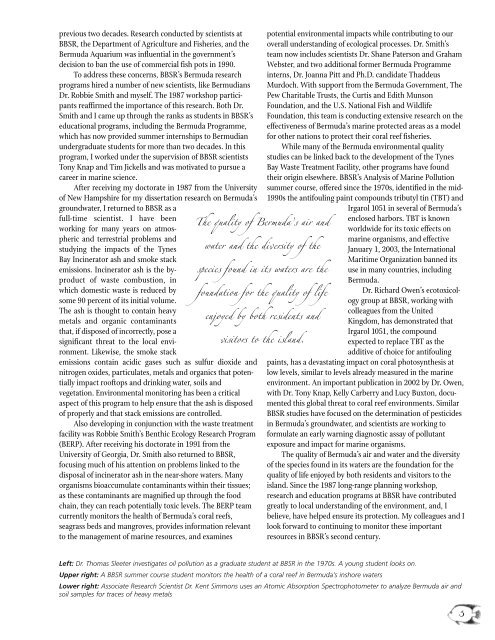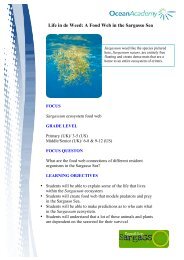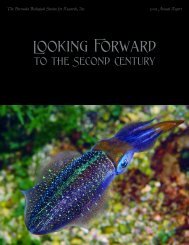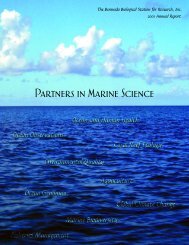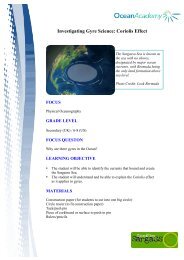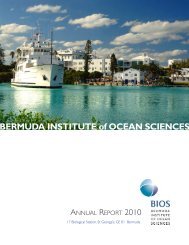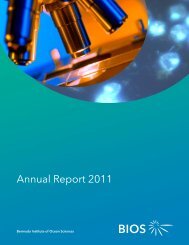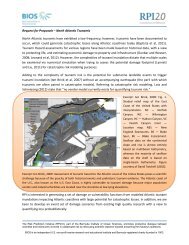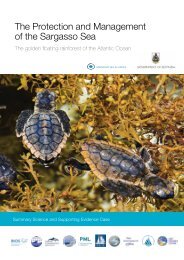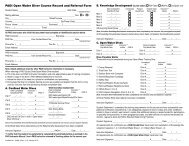BBSR 2002 Annual Report - Bermuda Institute of Ocean Sciences
BBSR 2002 Annual Report - Bermuda Institute of Ocean Sciences
BBSR 2002 Annual Report - Bermuda Institute of Ocean Sciences
You also want an ePaper? Increase the reach of your titles
YUMPU automatically turns print PDFs into web optimized ePapers that Google loves.
previous two decades. Research conducted by scientists at<strong>BBSR</strong>, the Department <strong>of</strong> Agriculture and Fisheries, and the<strong>Bermuda</strong> Aquarium was influential in the government’sdecision to ban the use <strong>of</strong> commercial fish pots in 1990.To address these concerns, <strong>BBSR</strong>’s <strong>Bermuda</strong> researchprograms hired a number <strong>of</strong> new scientists, like BermudiansDr. Robbie Smith and myself. The 1987 workshop participantsreaffirmed the importance <strong>of</strong> this research. Both Dr.Smith and I came up through the ranks as students in <strong>BBSR</strong>’seducational programs, including the <strong>Bermuda</strong> Programme,which has now provided summer internships to Bermudianundergraduate students for more than two decades. In thisprogram, I worked under the supervision <strong>of</strong> <strong>BBSR</strong> scientistsTony Knap and Tim Jickells and was motivated to pursue acareer in marine science.After receiving my doctorate in 1987 from the University<strong>of</strong> New Hampshire for my dissertation research on <strong>Bermuda</strong>’sgroundwater, I returned to <strong>BBSR</strong> as afull-time scientist. I have beenworking for many years on atmosphericand terrestrial problems andstudying the impacts <strong>of</strong> the TynesBay Incinerator ash and smoke stackemissions. Incinerator ash is the byproduct<strong>of</strong> waste combustion, inwhich domestic waste is reduced bysome 90 percent <strong>of</strong> its initial volume.The ash is thought to contain heavymetals and organic contaminantsthat, if disposed <strong>of</strong> incorrectly, pose asignificant threat to the local environment.Likewise, the smoke stackemissions contain acidic gases such as sulfur dioxide andnitrogen oxides, particulates, metals and organics that potentiallyimpact ro<strong>of</strong>tops and drinking water, soils andvegetation. Environmental monitoring has been a criticalaspect <strong>of</strong> this program to help ensure that the ash is disposed<strong>of</strong> properly and that stack emissions are controlled.Also developing in conjunction with the waste treatmentfacility was Robbie Smith’s Benthic Ecology Research Program(BERP). After receiving his doctorate in 1991 from theUniversity <strong>of</strong> Georgia, Dr. Smith also returned to <strong>BBSR</strong>,focusing much <strong>of</strong> his attention on problems linked to thedisposal <strong>of</strong> incinerator ash in the near-shore waters. Manyorganisms bioaccumulate contaminants within their tissues;as these contaminants are magnified up through the foodchain, they can reach potentially toxic levels. The BERP teamcurrently monitors the health <strong>of</strong> <strong>Bermuda</strong>’s coral reefs,seagrass beds and mangroves, provides information relevantto the management <strong>of</strong> marine resources, and examinesThe quality <strong>of</strong> <strong>Bermuda</strong>’s air andwater and the diversity <strong>of</strong> thespecies found in its waters are thefoundation for the quality <strong>of</strong> lifeenjoyed by both residents andvisitors to the island.potential environmental impacts while contributing to ouroverall understanding <strong>of</strong> ecological processes. Dr. Smith’steam now includes scientists Dr. Shane Paterson and GrahamWebster, and two additional former <strong>Bermuda</strong> Programmeinterns, Dr. Joanna Pitt and Ph.D. candidate ThaddeusMurdoch. With support from the <strong>Bermuda</strong> Government, ThePew Charitable Trusts, the Curtis and Edith MunsonFoundation, and the U.S. National Fish and WildlifeFoundation, this team is conducting extensive research on theeffectiveness <strong>of</strong> <strong>Bermuda</strong>’s marine protected areas as a modelfor other nations to protect their coral reef fisheries.While many <strong>of</strong> the <strong>Bermuda</strong> environmental qualitystudies can be linked back to the development <strong>of</strong> the TynesBay Waste Treatment Facility, other programs have foundtheir origin elsewhere. <strong>BBSR</strong>’s Analysis <strong>of</strong> Marine Pollutionsummer course, <strong>of</strong>fered since the 1970s, identified in the mid-1990s the antifouling paint compounds tributyl tin (TBT) andIrgarol 1051 in several <strong>of</strong> <strong>Bermuda</strong>’senclosed harbors. TBT is knownworldwide for its toxic effects onmarine organisms, and effectiveJanuary 1, 2003, the InternationalMaritime Organization banned itsuse in many countries, including<strong>Bermuda</strong>.Dr. Richard Owen’s ecotoxicologygroup at <strong>BBSR</strong>, working withcolleagues from the UnitedKingdom, has demonstrated thatIrgarol 1051, the compoundexpected to replace TBT as theadditive <strong>of</strong> choice for antifoulingpaints, has a devastating impact on coral photosynthesis atlow levels, similar to levels already measured in the marineenvironment. An important publication in <strong>2002</strong> by Dr. Owen,with Dr. Tony Knap, Kelly Carberry and Lucy Buxton, documentedthis global threat to coral reef environments. Similar<strong>BBSR</strong> studies have focused on the determination <strong>of</strong> pesticidesin <strong>Bermuda</strong>’s groundwater, and scientists are working t<strong>of</strong>ormulate an early warning diagnostic assay <strong>of</strong> pollutantexposure and impact for marine organisms.The quality <strong>of</strong> <strong>Bermuda</strong>’s air and water and the diversity<strong>of</strong> the species found in its waters are the foundation for thequality <strong>of</strong> life enjoyed by both residents and visitors to theisland. Since the 1987 long-range planning workshop,research and education programs at <strong>BBSR</strong> have contributedgreatly to local understanding <strong>of</strong> the environment, and, Ibelieve, have helped ensure its protection. My colleagues and Ilook forward to continuing to monitor these importantresources in <strong>BBSR</strong>’s second century.Left: Dr. Thomas Sleeter investigates oil pollution as a graduate student at <strong>BBSR</strong> in the 1970s. A young student looks on.Upper right: A <strong>BBSR</strong> summer course student monitors the health <strong>of</strong> a coral reef in <strong>Bermuda</strong>’s inshore watersLower right: Associate Research Scientist Dr. Kent Simmons uses an Atomic Absorption Spectrophotometer to analyze <strong>Bermuda</strong> air andsoil samples for traces <strong>of</strong> heavy metals5


